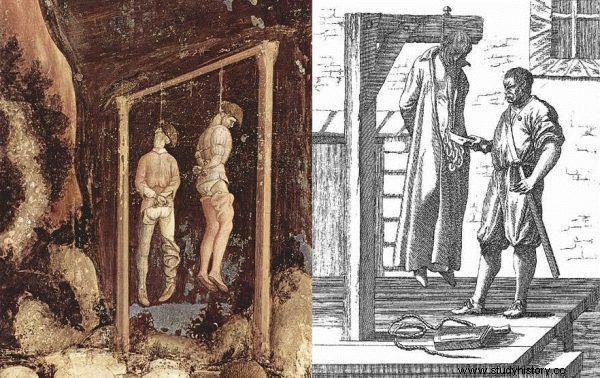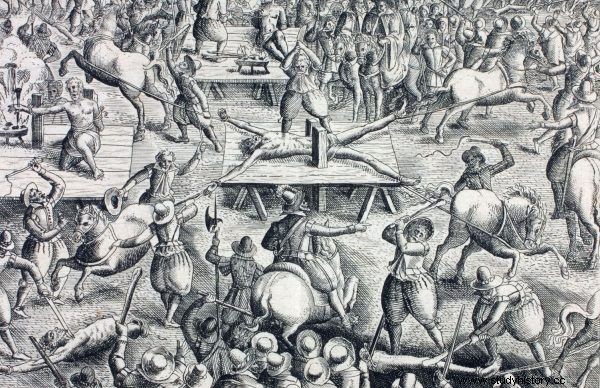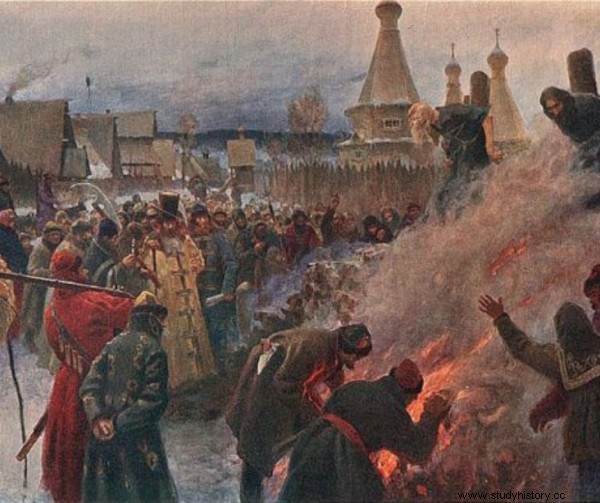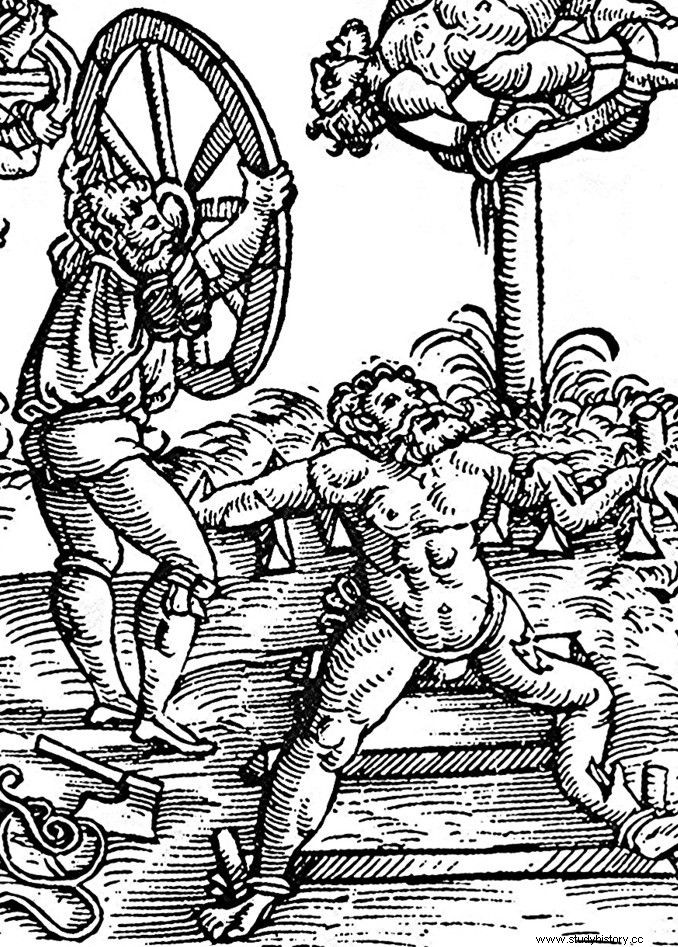In times without television, internet and tabloids, chatter had to look for cheap entertainment next to ... the city scaffold. The execution of the criminal was fun for commoners than the newest Turkish soap opera. And only the end of the show was far too easy to predict.
Public executions were staged deliberately. They were supposed to deter other grays thinking about going down the road of crime. In addition, ruthless punishment allowed the criminal to be permanently rid of society. In line with the words of King Stefan Batory, addressed to the persistent outlaw Samuel Zborowski: Canis mortuus non mordet. A dead dog does not bite.
5. Hanging preceded by fatigue
Normal hanging is just putting on the noose and kicking the footrest. However, the performance hanging could be spiced with the condemned ruffle, if tearing out the leg support did not break the spinal cord, and death was only brought about by slow suffocation. It was also possible to hang it by the legs, although the person who was hanging had to be "helped" in order to finally give up his ghost.

Hanging was the most common method of execution in the Middle Ages and the Modern Age. Sometimes, however, the hanging was accompanied by additional torment (source:public domain).
Another variation of this form of execution was classic hanging, but only after suffering torment. Bartosz of Lusina experienced it in 1559 in Kraków - a thief who had bad luck. By coincidence, he stole from the royal dignitary the piston of the royal seal, which was used to stamp official state documents. For the thief, it was worth the material, ultimately as a mere hoard, but the court classified the case as a political crime.
Bartosz was sentenced to branding and hanging. First, he toured the Main Square with the executioner. At each of the four corners of the square, the cart stopped. There, the executioner took from his assistants, carrying a cauldron of hot coals, a branding device and a white-hot iron, he burned a mark to Bartosz on the forehead, right breast, left breast and back. Only after being stigmatized, he was taken to the gates of the castle and hanged on the town gallows.
4. Quartering
It was reserved for more serious criminal cases. It was humane that it only happened after the death was inflicted - then the limbs and head were cut off. Often the latter was impaled and the limbs were placed on smaller gallows. Such a penalty was imposed, for example, on the perpetrators of road robberies, even if they were noble.
A variation was the quartering with the help of four horses, pulling the limbs in different directions. Such a sentence was carried out on Michał Piekarski, who on November 15, 1620, made an unsuccessful attempt on King Sigismund III Vasa. It was a great insult to the majesty and the entire nobility, who prided themselves that none of them had ever raised their hand as king - unlike degenerated Europe.
First, the perpetrator, as perhaps the only nobleman in history, was subjected to court torture with the consent of his lords. These only confirmed that the rogue is ill in the mind, which gave birth to the saying weave like Piekarski in torment. This was not, however, an extenuating circumstance. The court as a verdict copied the pattern taken from France, and the execution was a "spectacle" of its kind.
First, Piekarski was condemned to infamy and deprived of nobility. Then, on November 27, 1620, the actual "spectacle" took place - the condemned man was taken to the market square and torn with hot tongs. The hand he swung at the king was burned over the fire and cut off. The second one was cut off without smoking, in addition, he was thrown from the landing and his arms and legs were pierced. Finally, the grand finale began, when the still alive ex-nobleman was torn apart by four horses being driven in opposite directions.

A 17th-century illustration of a convict being torn by horses (source:public domain).
This trick was only successful when the executioner incised the victim's body. Then the horses tore off their right leg and Piekarski gave up the ghost. The torture lasted most of the executioner's working day - from 9 am to 4 pm. However, it was not the end of the sentence. The remains were collected and burnt, and the ashes were thrown into the Vistula.
3. Burning at the stake
This punishment was reserved mainly for heretics. Only fire could cleanse of such a grave sin as denial of faith, which brought the so far well-behaved sheep to the path of sin and eternal damnation.
In the modern era, the approach was not as strict as in the Middle Ages, when the inquisitor of the Dominican Order, Konrad Dorso, stated:. However, not everyone was as religiously tolerant as the 16th-century bishop of Krakow, Andrzej Zebrzydowski, who said: Let them believe in the goat, as long as they pay their tithes .
In Krakow, it was famous to burn Katarzyna Weiglowa at the stake in 1539, who was changed by the Jews, disdained her Christian faith . There was also a mentally ill, who attacked and injured a priest during the Holy Mass and trampled the Blessed Sacrament, as well as a thief of church silverware, which he later sold to Jews.

Burning at the stake was one of the forms of execution used throughout modern Europe. The picture shows a painting by Grigory Myasoyedov (source:public domain).
The piles were prepared and burned in the Main Square near the entrance to St. Mary's Church. It is worth adding that in Poland they burned much less frequently than in the West, and it was considered an act of grace to strangle the condemned person just before setting the fire so that he would not burn alive.
2. Pile driven
This method was used not only by Vlad III the Impaler (known as Dracula), or by Jeremy Wiśniowiecki in the Wild Fields. It was spectacular and awe-inspiring, and when loaded, he could tire for three days. The rule was that a sharpened pole was hammered into the anus or groin of a lying condemned man with the help of draft horses. Then the whole thing was lifted upright and embedded in the ground, and the condemned man, under the influence of his weight, fell lower and lower, while the stake tore his body and pierced other organs.
Such a sentence was issued and carried out on Aleksander Kostka Napierski, who, with the help of Marcin Radocki and Stanisław Łętowski, in June 1651 organized peasant troops, took the castle in Czorsztyn and tried to initiate a rebellion in Podhale. At the same time, King Jan Kazimierz was heading with his troops to deal with the Cossacks at Beresteczko.
It is true that he won the battle, but he had to weaken his forces before the battle and send a unit of 2,000 to defend the far hinterland. Napierski was accused of treason, and he himself confessed to dealing with Bohdan Chmielnicki and Jerzy II Rakoczy.
On July 18, 1651, in the then Krzemionki hills near Krakow, the sentence was carried out - Radocki was beheaded, Łętowski was quartered, and Kostka was impaled. The latter had additional bad luck, because, as the witness of the execution, Wawrzyniec Rudawski wrote , "due to the executioner's awkwardness, he was impaled ten times on a sharp pole" .
The poet from the era of Wespazjan Kochowski commemorated this event by joking about King Jan Kazimierz, who personally approved the sentence on Napierski:
I don't know what the new cook is,
City of roasts, he spit our dice.
1. Breaking with a wheel
The execution was long and brutal - the naked condemned man was tied to the ground with his arms and legs stretched out. A piece of wood was placed under each joint - under the ankles, knees, hips, shoulders, elbows, and wrists. It was there that the angle of the wheel was hitting, i.e. an angular wooden club, additionally covered with metal.

Breaking a circle in a modern illustration (source:public domain).
This was the end of the Prague Jew Löbel Kurtzhandl in 1694, accused of killing an Orthodox Christian boy who wanted to convert to Christianity. A detailed description of the torment - based on the accounts of witnesses of those events - is quoted in his novel "The Terrible News about the Murder of Szymon Abeles" by Marek Toman. The last experiences of a condemned man in this world were thirty strokes of a 40-kilogram wheel on the legs and arms, and over ten more on the chest.
If the unfortunate person decided to convert during the trial and convert to Christianity, then the executioner would use the milder version - he would start blows from the chest and break the spinal cord. Then both the convict would suffer less, and the execution would last the same, because the executioner would hit the dead body with the wheel, so the audience would also have their bloody entertainment.
Inspiration:
The publication of this article was inspired by Marek Toman's novel Scary News about the cruel murder of Szymon Abeles .
Bibliography:
- Christine Caldwell Ames, The Inquisition and the Brothers of St. Dominica. Righteous Persecution , Poznań 2013
- Timothy Brook, Jerome Bourgon, Gregory Blue, A History of Chinese Torture , Warsaw 2010
- Aleksander Brückner, Old Polish Encyclopedia, Warsaw 1990
- Tomasz Gałuszka OP, The Inquisitor is also a man. Intriguing pages of the Church , Poznań 2016
- Jan Kracik, Michał Rożek, Hultaje, villains, harlots in old Krakow. On the social margin of the 16th-18th centuries , Krakow 1986
- Paweł Jasienica, Jagiellonian Poland , Warsaw 1988
- Piotr Lewandowski, To kill the king! Michał Piekarski's attack on Zygmunt III Waza, Warsaw 2012
- Andrzej Nazar, Esoteric Krakow, Krakow 2010
- Michał Rożek, Krakow. Stories Untold. People - events - customs ”, Krakow 2008
- Janusz Tazbir, Poland at the turns of history , Warsaw 1997
- Szymon Wrzesiński, The Damned of Medieval Europe , Krakow 2007
